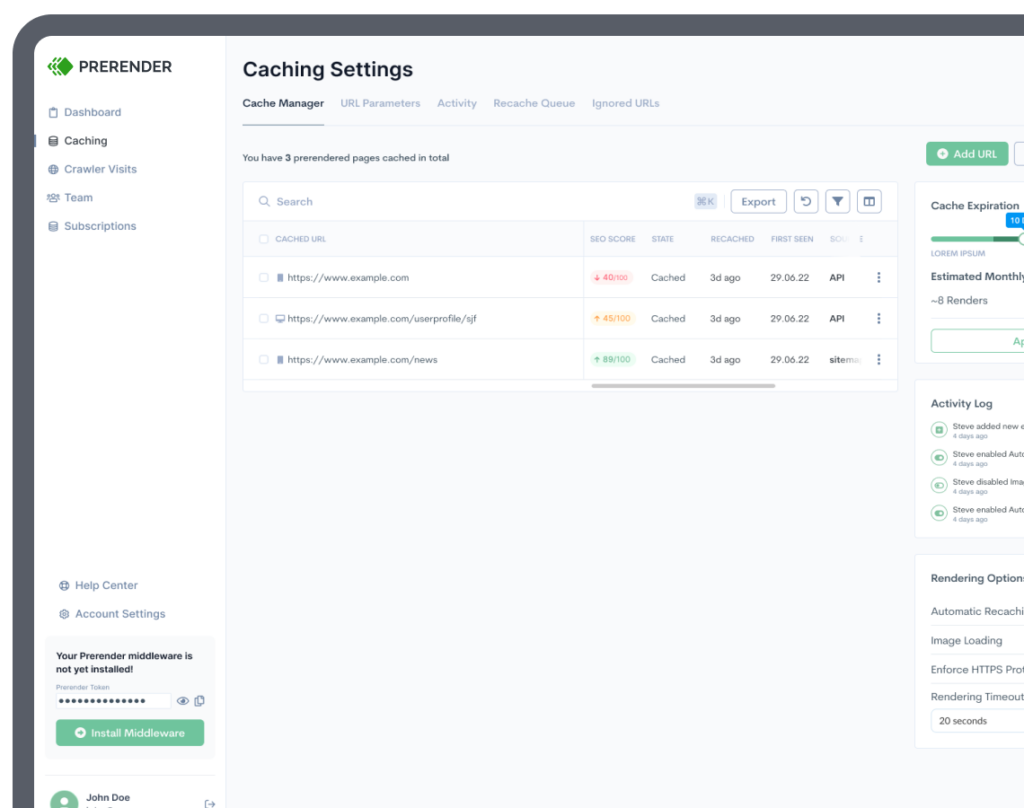Today, delivering personalized, relevant, and fast-loading experiences is key to engaging customers and driving better results, and dynamic content, which adapts based on user data and context, has become indispensable for businesses aiming to create tailored user journeys at scale.
However, dynamic content often relies on JavaScript and client-side rendering, which can pose challenges for SEO. While JavaScript itself is not necessarily problematic for search engines, the client-side rendering it often enables can make it difficult for crawlers to access and index the dynamic content properly. As a result, your website may experience a lower search ranking and poor discoverability.
Don’t worry, there’s a simple solution; Prerender. Prerender is a middleware that pre-renders JavaScript-powered websites into static HTML files, ensuring that search engine crawlers can access and index the content effectively. By doing so, businesses can overcome the challenges associated with dynamic content and drive more organic traffic to their websites.
In this article, we will give more context on dynamic content and how to manage it with Prerender.
What is Dynamic Content?
Dynamic content refers to website or application content that changes in response to user interactions, preferences, location, or other contextual information. Unlike static content, which is the same for all users and accessible every time, dynamic content is generated or updated on the go, often in real time.
Dynamic content can take many forms, including:
- Personalized recommendations: Websites like Amazon or Netflix use dynamic content to recommend products or movies based on a user’s past interactions and preferences.
- User-generated content: Social media platforms display dynamic content generated by users, such as posts, comments, and updates.
- Real-time updates: News websites and financial platforms often display dynamic content that updates in real time, providing users with the latest information.
- Interactive elements: Dynamic content can include interactive elements like forms, quizzes, or surveys that adapt based on user input.
- Location-based content: Apps and websites use dynamic content to provide location-specific information, such as local weather forecasts, nearby restaurants, or events.
Several technologies, including JavaScript, are responsible for dynamic content—they make great things happen right before your eyes! When you load a webpage, Javascript alters content based on user interactions or other triggers, allowing the website to update text, replace images, or even load new content—all without needing to reload the entire page.
So, next time you see a webpage that feels alive and interactive, JavaScript (alongside other modern frameworks) is likely behind the scenes, pulling the strings to make everything happen dynamically.
The Challenge With Javascript and Search Engines
While dynamic content is amazing, it presents a unique challenge to search engines and SEO. Search engines rely on crawlers to navigate and index websites, but these bots struggle to handle JavaScript-heavy pages that have dynamic content.
Compared to static HTML sites, search engines take 9x longer to crawl and index sites with dynamic content. This causes JavaScript-based web pages to demand more resources from Google for crawling, indexing, and rendering, consuming a significant portion of their crawl budget.
Since search engines must dedicate more resources to rendering your JavaScript pages, many elements of your page won’t get indexed. This leads to issues such as missing content, limited crawl budgets, and half-rendered pages that compromise your search performance.
To address this SEO challenge, developers have three main options:
- Server-side rendering (SSR): Here, the rendering happens on the server rather than relying on search engines. This approach saves significant time and resources for both users and search engines but is expensive and complex to set up.
- Client-side rendering (CSR): JavaScript frameworks like Vue and React use CSR. This approach is more cost-effective, but sadly, many search engines can’t execute JavaScript.
- Prerendering, which even Google recommends as the best solution.
What is Prerendering?
Pre-rendering is a technique that ensures web crawlers can efficiently access and index the content of modern JavaScript-heavy websites.
When a bot tries to access a page, a special pre-rendering service kicks in and sends a pre-rendered, static version instead of the regular, JavaScript-powered one. This static version contains the fully rendered DOM, including all JavaScript components, images, and other assets—more like a snapshot of the page post-JavaScript processing.
While regular users enjoy seamless interaction with the website’s dynamic features powered by JavaScript, bots receive an optimized, pre-rendered version that, thanks to Javascript SEO rendering, is easy to crawl and index properly.
But to enable this process, your servers need to be able to distinguish between human users and bots, cache fully rendered versions of your pages, and execute the rendering process efficiently.
However, implementing and maintaining this process independently can be expensive and labor-intensive. This is where solutions like Prerender for Javascript SEO come in.
What is Prerender?
Prerender is a service that helps search engines to crawl and index dynamic content effectively. It uses dynamic rendering (which can be considered an advanced version of prerendering) and works by pre-rendering your JS-powered website into static HTML files, which search engines can easily crawl and understand.
Prerender offers several key features and benefits:
- Improved SEO: By ensuring that search engines can crawl and index your dynamic content, Prerender can lead to better search rankings and increased organic traffic.
- Compatibility with popular frameworks: Prerender seamlessly integrates with popular JavaScript frameworks, such as React, Angular, Vue.js, and others.
- Easy integration: Prerender can be integrated into your existing website or application with minimal effort, either through a hosted service or by self-hosting the Prerender software.
- Customizable caching: Prerender allows you to configure caching rules to optimize performance and reduce server load.
- Analytics and monitoring: Prerender provides analytics and monitoring tools to help you track and optimize the performance of your pre-rendered content.
Leveraging Prerender will solve all of your JavaScript SEO problems, ensure that search engines index your pages, and display your pages properly in the SERPs — giving your site a competitive edge.
Are you interested in outsourcing your pre-rendering work to us and optimizing your site for SEO? Our Prerender pricing is designed to suit your needs, so you can get started and efficiently manage the process without breaking the bank.
How To Manage Dynamic Content Challenges With Prerender
You can solve Javascript SEO and visibility challenges with Prerender in four steps:
Step 1: Set Up for Prerender
To integrate Prerender with your website, start by creating an account on the Prerender website. You can choose between the hosted service or self-hosting the Prerender software.
Setting up Prerender is straightforward. Simply install the appropriate middleware tailored to your tech stack onto your backend/CDN/web server. Prerender is compatible with almost any tech stack, including ExpressJS, Rails, Cloudflare, Java, C#, PHP, Python, and more.
Once installed, test the setup to ensure it’s functioning correctly. During setup, you’ll receive an API token for authentication with the Prerender service.
Step 2: Rendering
Prerendering is Prerender’s core functionality.
When a crawler requests a page from your website, Prerender intercepts the request and checks if the page needs dynamic rendering. If it contains JavaScript-generated content, Prerender spins up a headless browser instance (typically Chromium or Firefox) and loads the requested URL.
This browser instance executes all JavaScript on the page, fully rendering the dynamic content, thus enabling search engines to index the page effectively.
If the requested page is not present in the cache (cache miss), Prerender retrieves the necessary files from your server, renders the page, and sends it as a rendered static page after a few seconds.
Step 3: Caching
Once a page is rendered, Prerender caches the resulting HTML snapshot. This caching mechanism improves performance by serving pre-rendered HTML directly for subsequent crawler requests, reducing server load and improving scalability, response speed, and crawl budget. It also provides an accurate snapshot of your page for indexation.
Step 4: SEO Performance
Prerender includes a technical SEO scoring feature integrated into the rendering process. The score is displayed in the cached page results, allowing clients to assess their pages’ technical health.
While the SEO score doesn’t directly correlate with SERP rankings, it helps identify technical issues that may impact search engine visibility.
Conclusion
With the four simple steps mentioned above, Prerender (and Prerendering) can help solve those annoying JavaScript SEO problems by creating a fully rendered version of your SPAs or dynamic pages, all without sacrificing user experience or performance.
In fact, numerous companies and websites in various industries have jumped on the Prerender train, and it’s been a game-changer for managing dynamic content and boosting their search visibility.
For example, Eldorado, a platform enabling gamers to trade digital gaming currencies and items, successfully tackled rendering issues on its single-page application (SPA) website by integrating Prerender. This approach led to a remarkable 53% surge in traffic within two months, followed by an impressive 80% increase after ten months. Plus, indexed pages rose 32%, and the platform achieved a “Top 3” spot for high-performing keywords. Talk about a win!
Are you interested in exploring how Prerender can benefit your brand? Start with a free trial and receive 1,000 URL renders per month for free.



